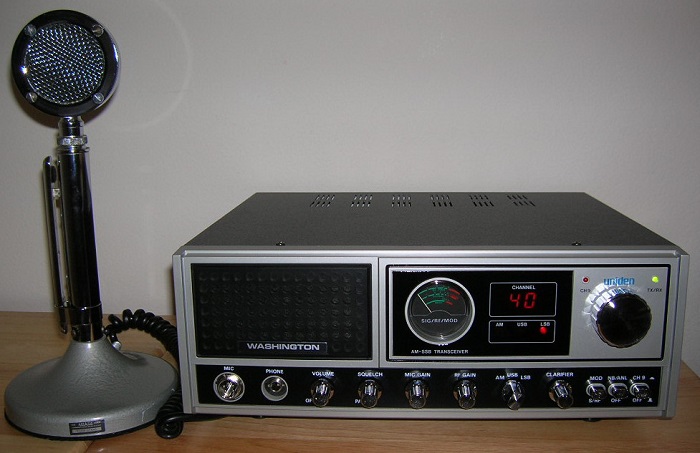
Severe weather, EMP, solar flares, terrorist attack, or governmental collapse could cause an emergency situation where your cell phone and internet no longer work. Having a Citizen Band radio (CB) can help you stay up to date on the latest happenings because you can both receive critical bulletins and request assistance if need be.
CB radios will likely still function after an EMP scenario. The likelihood increases if they are stored in a Faraday cage and have an alternative power source, like batteries, which also have been safely stored.
What is a CB Radio?

A CB radio is a citizens band radio. It is a land mobile system that allows short-distance voice communication between individuals. They have a range from three to twenty miles, although some conditions will allow for intermittent communication over a much larger distance. Most countries do not require a license for you to operate one.
If you already have a CB radio – nice! Welcome to the club. If you’re here pondering buying one, I suggest first reading my suggestions on the 5 best CB radios out there.
Why is it Important to Learn CB Codes?
Because only one person can transmit on a frequency channel at a time, using a standard language streamlines communication. Whether you are using a vehicle-mounted, base station with external antenna, or handheld CB, the communication codes are the same.
For preppers, having access to communication in various forms is a powerful tool for you and your family’s readiness. You need to know how to speak and understand the language being used, however.
Are there Restrictions to CB Radio Use?
Channel 9 is restricted to emergency communications, including roadside assistance by the FCC. You can find the complete reference guide from the FCC here and the rules for operating a CB radio here.
Related article: Police Scanners for Home Preparedness and Bug Out Bags
Most drivers monitor channel 19 to stay up to date on accidents, speed traps, and road construction. This channel should not be used for chitchat.
CB Radio Language
Many users identify themselves with nicknames known as handles. Using a handle rather than your own name allows you to maintain a level of anonymity. You can see if someone, in particular, is currently on the radio by saying their handle followed by “Got your ears on?”
Most of the terms we’ll look at use number pairs beginning with 10 to communicate ideas.
- 10-1 indicates you are receiving poor reception.
- 10-2 indicates you are receiving good reception.
- 10-3 means stop transmitting.
- 10-4 confirms that a transmission is understood. It can also be used to mean agreement. Copy, copy that, or roger are other ways to say that you understood the communication. 4-10 reverse the numbers from 10-4. You use this when you want confirmation from the listener. The speaker wants confirmation that the transmission was understood or agreed with.
- 10-5 means relay the message.
- 10-6 indicates someone is busy, sort of like BRB (be right back). 10-7 is used when you are signing off and will make no further transmissions for a time. Over and out is another expression meaning you are leaving the conversation.
- 10-7 means you are out of service or leaving the air.
- 10-8 lets the listener know that someone is on the way. 10-9 means the last transmission was not received and should be repeated.
- 10-9 is a request to repeat a message.
- 10-10 Listening but not participating is also known as sandbagging. 10-10 lets the listener know that you will not be broadcasting but are still listening or standing by. You could also use the phrase “taking a standby.” 10-23 is a request to the other person to stand by.
- 10-11 is used to indicate the person on the other end is speaking too quickly.
- 10-12 means visitors are present.
- 10-13 is used when you are looking for advise on weather and road conditions.
- 10-16 means “make a pickup at …”
- 10-17 is “urgent business.”
- 10-19 means everything is done and return to base.
- 10-20 (sometimes just 20) is for location. You could ask for someone’s 20 if you want to know where they are or give your own 20 to give the other person your location. The “mayday” code used for emergency broadcasting is 10-33.
- 10-21 means call by telephone.
- 10-23 is stand by.
- 10-33 is emergency traffic at this station.
- 10-34 means trouble at this station – help is needed.
- 10-35 is used to indicate confidential information.
- 10-41 is an indication to change the channel to …
- 10-42 means traffic accident a …
- 10-45 is a request for all units within range to report.
- 10-62 is used to indicated unable to copy and to use a phone.
- 10-65 means you are awaiting your next assignment.
- 10-67 is a command for all units to comply.
- 10-70 is fire at …
- 10-73 is speed trap at …
- 10-77 means negative contact.
- 10-91 is a request for the speaker to talk closer to the mic.
- 10-99 means mission accomplished
- 10-100 is used to tell someone you need to go to the bathroom.
- 10-200 means police needed at …
Break or breaker, followed by a number, lets other users know that you want to start transmission on a specific channel. So, for instance, Breaker one-five would refer to channel 15. This term is used because you may be “breaking” into another conversation. Affirmative is another term for yes. Negatory is no.
The Uniden 40-Channel Trucker’s CB Radio is a common CB radio suitable for bug out vehicles.
Jabber or babble refers to incomprehensible transmissions. The speaker may be speaking in a foreign language or have inadequate transmission equipment. A mud duck is a person that has a weak signal but continues to talk, although what they are saying is not understandable. On the other end of the spectrum, an alligator station has good transmission but isn’t receiving well, also identified as 10-1. 10-2 is receiving well. To indicate that someone should stop transmitting, use 10-3.
If your technique needs a little work, you might hear 10-91 (talk close to the mic) or 10-92 (your transmitter needs adjustment). 10-11 means you are talking too quickly. If you need someone to help you out, 10-93 asks a listener to check your frequency. Audio (pronounced something like “aaaauuuudddiiiioooo”) can be used to verify your audio or power output.
CB Etiquette
Respecting air time and other users are vital to successful CB use. Because only one person can speak at a time, you’ll need to be careful you aren’t interrupting an ongoing conversation when you break in. This is also referred to as stepping on or walking over. When more than one user tries to use the same channel, no one can be understood.
Midland USA also sells various CB and two-way radios.
On some occasions, you may need to yield to other, more pressing situations such as accidents, road condition updates, and so on. Be patient and wait your turn. Keep your transmissions short. Use the lingo to facilitate communication.
Where to Learn More About CB Radio Talk
The terms in this article by no means make up an all-inclusive list. Truckers use more than a hundred 10 codes to communicate among themselves, some of which you might never need to use yourself. One of the best ways to learn any language, including CB radio language, is to listen to it being spoken in an authentic context.
Begin by streaming live CB radio channels when you have time. The CB Radio Club has a listing you can check out to find one in your area. Broadcastify is a New York/New Jersey channel, and Live CB Radio is out of Lincoln, Nebraska.
Recap
Knowing how to communicate efficiently on a CB radio is an excellent skill to acquire before an SHTF situation. Odds are good that even after disasters such as EMPs and solar flares, the CB radio you have safely stored away will come in handy. Besides, learning a new language, especially the colorfully descriptive trucker lingo, is fun. What have you got to lose?
